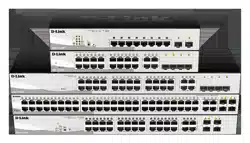Loading ...
Loading ...
Loading ...

4 Configuration D-Link Smart Managed Switch User Manual
4
4
7
7
Passive - LACP ports that are designated as passive cannot initially send LACP control frames. In
order to allow the linked port group to negotiate adjustments and make changes dynamically, one
end of the connection must have "active" LACP ports.
Timeout: Specify the administrative LACP timeout. The possible field values are:
Short (3 Sec) - Defines the LACP timeout as 3 seconds.
Long (90 Sec) - Defines the LACP timeout as 90 seconds. This is the default value.
Click Apply to implement the changes made.
L2 Functions > Multicast > IGMP Snooping
With Internet Group Management Protocol (IGMP) snooping, the Smart Managed Switch can make
intelligent multicast forwarding decisions by examining the contents of each frame’s Layer 2 MAC header.
IGMP snooping can help reduce cluttered traffic on the LAN. With IGMP snooping enabled globally, the
Smart Managed Switch will forward multicast traffic only to connections that have group members attached.
The default IGMP Snooping version is v3, which works compatible with IGMP versions v1 and v2.
The DGS-1210 series support IGMP v1/v2/v3 awareness. And the IGMP v3 awareness means that we do
support IGMP v3 snooping, in other words, switch can read/understand the IGMP control packet which is
version3. The Switch still can based on its report/leave packet to do the correct behavior. But from the RFC
point of view, full IGMP v3 means that it should support source filtering and it’s not possible to support on the
L2 switch.
The settings of IGMP snooping is set by each VLAN individually.
Figure 4.54 – L2 Functions > Multicast > IGMP Snooping
By default, IGMP is disabled. If enabled, the IGMP Global Settings will need to be entered:
Host Timeout (130-153025 sec): This is the interval after which a learned host port entry will be purged. For
each host port learned, a 'Port Purge Timer' runs for 'Host Port Purge Interval'. This timer will be restarted
whenever a report message from host is received over that port. If no report messages are received for 'Host
Port Purge Interval' time, the learned host entry will be purged from the multicast group. The default value is
260 seconds.
Robustness Variable (2-255 sec): The Robustness Variable allows adjustment for the expected packet loss
on a subnet. If a subnet is expected to be lossy, the Robustness Variable may need to be increased. The
Robustness Variable cannot be set to zero, and it SHOULD NOT be. Default is 2 seconds.
Loading ...
Loading ...
Loading ...
